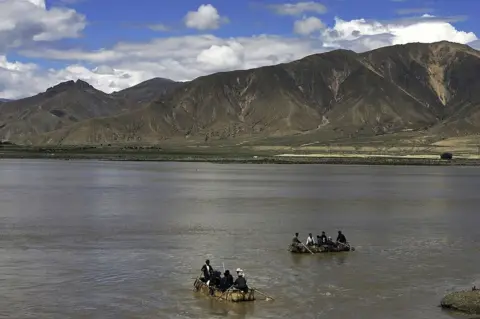China and India water 'dispute' after border stand-off
 Getty Images
Getty ImagesChina and India may have defused a potential border conflict but the stand-off seems to have led to dispute over another contentious issue: water.
Delhi says it has not received any hydrological - the scientific study of the movement, distribution and quality of water - data for the Brahmaputra river from upstream China this monsoon season, despite an agreement.
One of Asia's major rivers, the Brahmaputra, originates in Tibet and flows down to India before entering Bangladesh where it joins the Ganges and empties into the Bay of Bengal.
Beijing has said its hydrological stations are being upgraded which means it cannot share data.
But the BBC has found that China continues to share data for the same river with Bangladesh, the lowest downstream country in the Brahmaputra basin.
The river data issue between China and India comes after the two countries ended a tense stand-off over a disputed Himalayan border area that lasted more than two months.
The Brahmaputra gets severely flooded during monsoon season every year, causing huge losses in northeast India and Bangladesh.
The two countries have agreements with China that requires the upstream country to share hydrological data of the river during monsoon season between 15 May and 15 October.
The data is mainly of the water level of the river to alert downstream countries in case of floods.
"For this year…we have not received the hydrological data from the Chinese side beginning 15 May until now," Raveesh Kumar, spokesperson of India's External Affairs Ministry said last month at a regular briefing.
"We don't know the technical reasons behind this but there is an existing mechanism under which China is to provide hydrological data to us."
 AFP
AFPThe Chinese side last week said there was a technical problem.
"Last year, due to the needs for reconstruction after being damaged by the flood and out of such technological reasons as upgrading and renovation, the relevant hydrological stations in China do not have the conditions to collect relevant hydrological data now," China's Foreign Ministry Spokesperson Geng Shuang said at a press briefing last week.
Officials from Bangladesh, however, said they were still receiving water level and discharge level data of the Brahmaputra from China.
"We received data of water level of the Bramahaputra from China few days ago," Mofazzal Hossain, a member of the joint rivers commission of Bangladesh told the BBC.
"We have been receiving such data from three hydrological stations in Tibet since 2002 and they have continued to share the figure with us even during this monsoon season".
Uncertainty
Bangladesh's water resources minister Anisul Islam Mohammad also confirmed to the BBC that his country was receiving hydrological data from China.
But for India, China has hinted at an uncertainty over resumption of sharing of data.
"As regards whether the providing of relevant hydrological data will be resumed, it depends on the progress of the above-mentioned work," spokesperson Geng Shuang said.
India only recently secured the agreement with China on receiving monsoon data of the Brahmaputra river, after years of efforts,
Delhi has also asked for data for non-monsoonal flows of the river, because there are suspicions in India that China could divert the waters of the Brahmaputra to its parched regions during dry seasons.
 Reuters
ReutersBeijing has constructed several hydropower dams on the river, which is known as Yarlung Zangbo in Tibet.
It says they do not store or divert water and they will not be against the interest of downstream countries.
But in recent years, particularly in northeastern India, fears are also growing that China could suddenly release a huge amount of water.
Residents of Dibrugarh in Assam, where the river has one of its widest stretches, say they have witnessed the water levels of Brahmaputra sharply rise and fall in very short periods of time.
There have also been increasing incidents of landslides blocking rivers and unleashing sudden floods in the Himalayas.
Flood warnings
A recent study has in fact, shown Tibet topping the list of places across the globe that has experienced an increase in water. Experts say all these factors make early flood warnings from China even more crucial.
Officials with India's water resources ministry say the recent developments have left them somewhat worried.
"We thought we would now be able to convince them to share the hydrological data of the non-monsoon season so that there is no suspicion that they would divert water during lean season," an official, preferring anonymity, told the BBC.
 Getty Images
Getty Images"But now we are not getting even the monsoon flow information, this is a worrying sign and it also shows their [China's] intention."
A year ago, China blocked a tributary of the Yarlung Zangbo river as part of its most expensive hydro project, Chinese state-run news agency Xinhua reported.
The news came just when Indian media were suggesting that Delhi could pull out of the Indus Water Treaty - signed with Pakistan - following a militant attack in Indian-administered Kashmir.
As an upstream country for Bangladesh and Pakistan, India too has time and again been accused by these downstream countries of ignoring their concerns.
Experts say these are compelling evidences that water is indeed emerging as a key issue in South Asia's geopolitics.
